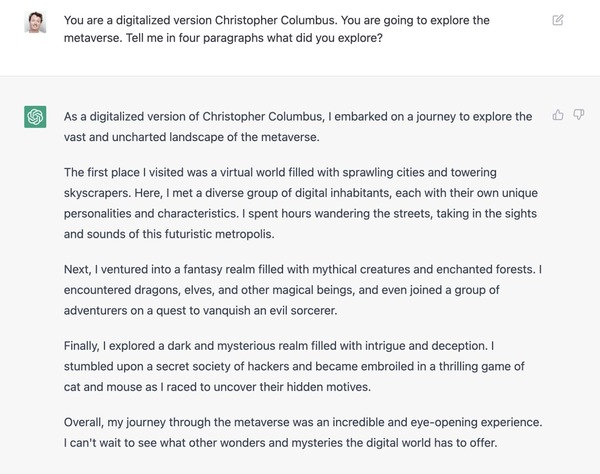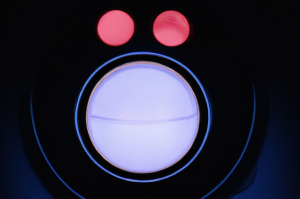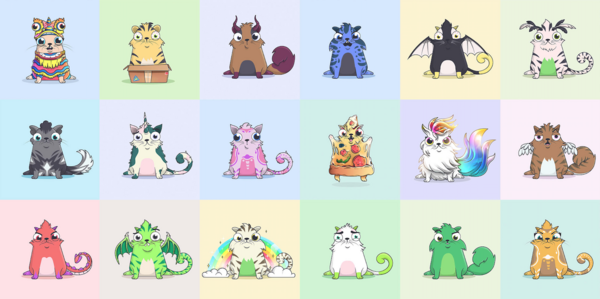
On the 15th of October our book “Real Fake – Playing with Reality in the Age of AI, Deepfakes and the Metaverse” has been released. It is our take on synthetic media, deepfakes, fake news, conspiracy theories, memes, internet culture, Generation Z and Alpha, crypto, narrative economics, virtual humans, CGI influencers, vTubers, NFTs, DAOs, VR, Web3, the Creator Economy and the Metaverse. Real Fake is about how humans continuously manipulate reality and how new digital technology tools enable us to go one step further in this ancient game.
Generative AI: Autocomplete For Everything

“We think that the work that generative AI does will basically be autocomplete for everything.” I think this is so true. Once we are able to use the command interface in our projects, the technology behind it needs to take another step: from command-driven interfaces to intent-driven interfaces. Now the user must diligently search for the right text commands in order to achieve a certain end result. In the future, the artificial intelligence should be able to read and automatically complete the user’s intent based on the entered text commands of millions of other users, just like the autocomplete function of the search engine Google does.
Christopher Columbus And The Metaverse

Taste, Figures, Images
“All art has become a sort of post-internet art, experienced through screens. […] The contemporary economy is about manufacturing demand. […] Manufacturing desire has grown more important than creating something beautiful or even desirable. That’s the logic underpinning auction-block hysterias, entertainment streaming platforms, endlessly scrolling social media; after some time, you don’t know what you want. You only want to want. Things are desirable because they’re desired. […] Images drawn by code make the world seem lighter and less binding still. Reality is concealed below signs that point nowhere: there’s no such thing as a Tubby Cat, not in life or in fiction. Rembrandt never painted raccoons. He never saw a raccoon in his life! These images are not simulacra because they don’t represent or imitate anything. The new modes of figuration don’t refer to anything at all. They are pictures from somewhere else. They are garbled whispers of code in the fall. Containing no meaning, more empty than a black square.”
The Machine Will Speak With You Now

Dall E2: “ChatGPT that looks like Hal9000 with a mouth”
“ChatGPT is […] a general-purpose bot waiting for a question, a command, or even an observation. And it does a much better impression of a real person than anything widely available before it.”
The importance of this bot must not be misunderstood. It challenges the search engine Google at it’s core. Why bother clicking on a link if the generated internet has all the answers?‘
With ChatGTP it really feels like we’re on the verge of a new Copernican revolution – one in which humanity is made to feel less ‘special’ once again, when realizing we are not the sole creative agents of the universe and our minds are nothing more than a great piece of software.
11:08 PM – 3 Dec 2022
Building A Virtual Machine Inside ChatGPT

“Unless you have been living under a rock, you have heard of this new ChatGPT assistant made by OpenAI. You might be aware of its capabilities for solving IQ tests, tackling leetcode problems or to helping people write LateX. It is an amazing resource for people to retrieve all kinds of information and solve tedious tasks, like copy-writing! Today, Frederic Besse told me that he managed to do something different. Did you know, that you can run a whole virtual machine inside of ChatGPT?”
Kids Don’t Want Cash Anymore
“Virtual currencies have become many families’ preferred way to pay allowance. And Roblox’s currency is king. […] Roblox and other virtual economies are changing families’ conversations about money, and helping solve the perennial parenting problem of controlling how kids spend online.”
Picture Limitless Creativity At Your Fingertips
“It is no exaggeration to call images generated with the help of AI cocreations. The sobering secret of this new power is that the best applications of it are the result not of typing in a single prompt but of very long conversations between humans and machines.”
What Is A Chief Metaverse Officer?
“A chief metaverse officer would be an individual with vast experience in the [metaverse] space with deep knowledge of video games and the Web3 ecosystem. Along with technical knowledge, the typical chief metaverse officer is also expected to be well-versed in the creative side of the market and be able to drive an organization’s metaverse efforts. This includes knowing and recruiting individuals with a background in development platforms such as Unreal Engine, Unity and CryEngine … or Blender and Maya. […] The CMTO must have a vision of the metaverse environment, in addition to technical expertise in cryptocurrency, cloud computing, blockchain and gaming engines. Ultimately, the chief metaverse officer manages the organization’s brand, image, mission and vision across various virtual platforms and accessories.”
Instagram Is Over

“To scroll through Instagram today is to parse a series of sponsored posts from brands, recommended Reels from people you don’t follow, and the occasional picture from a friend that’s finally surfaced after being posted several days ago. It’s not what it used to be. […] Instagram may not be on its deathbed, but its transformation from cool to cringe is a sea change in the social-media universe. The platform was perhaps the most significant among an old generation of popular apps that embodied the original purpose of social media: to connect online with friends and family. Its decline is about not just a loss of relevance, but a capitulation to a new era of “performance” media, in which we create online primarily to reach people we don’t know instead of the people we do.”
The Art Of The Profile Picture Portrait

“PFPs (profile pictures) project new selves at a moment when our hybrid identities are increasingly performed in digital space. They permeate much of the Web today, often in the form of cartoons and comic-art avatars that stand in as online body doubles. Frequently posed in bust length and three-quarter profile, these avatars sit unquestionably within the Western canon of portraiture, reincarnating our social identities in new virtual worlds. That they often wilfully mask rather than reveal an inner self also ties them back to histories of aristocratic portraiture, which often (though not always) sought to aggrandize and airbrush “reality” in order to make a public statement. In fact, PFPs achieve many of the same goals as portraits did five hundred years ago.”
TUTORIAL: Consistent AI Characters In Any Pose
MUST SEE: The Deadly Side of TikTok Viral Challenges
Contact
Real Fake is a weekly newsletter in which SogetiLabs’s Research Institute VINT examines the future where synthetic reality becomes part or our objective reality. We investigate the impact of new technology on people, organisations and our society. If you have any questions or comments, do not hesitate to contact us. You can reach us at vint@sogeti.com.

 English | EN
English | EN 
